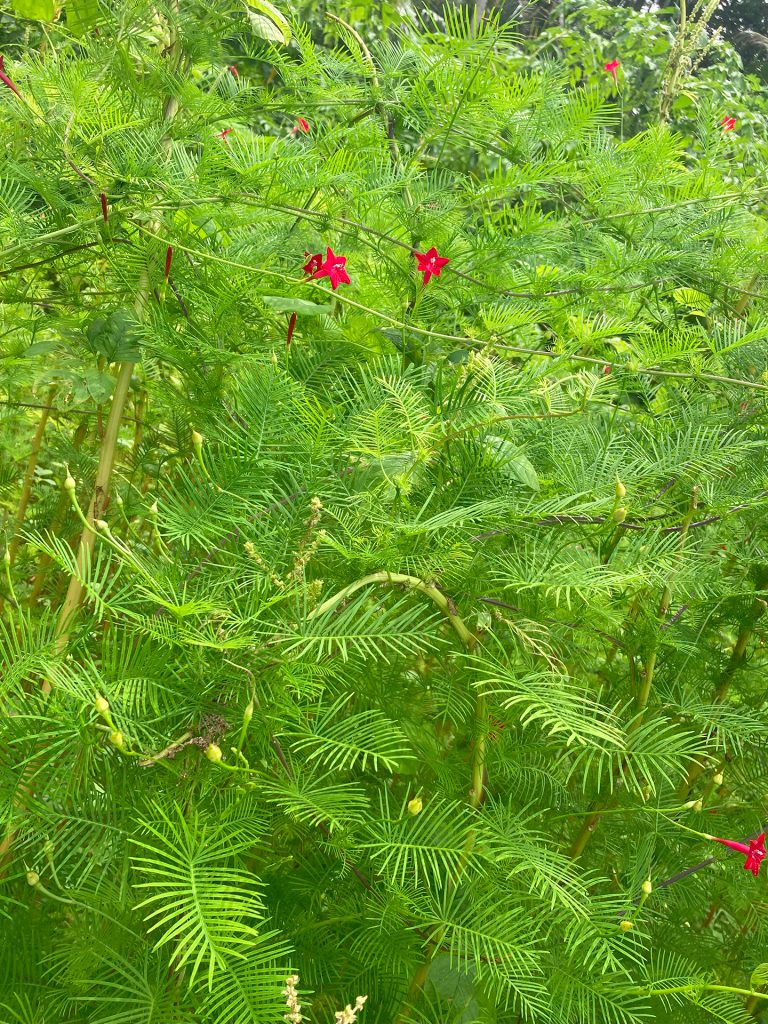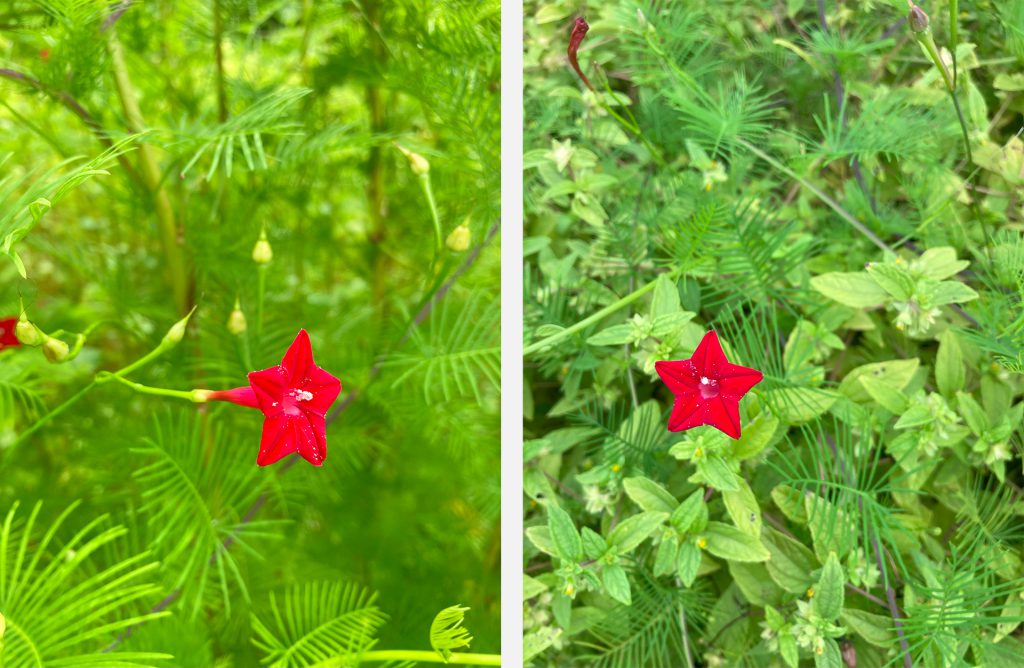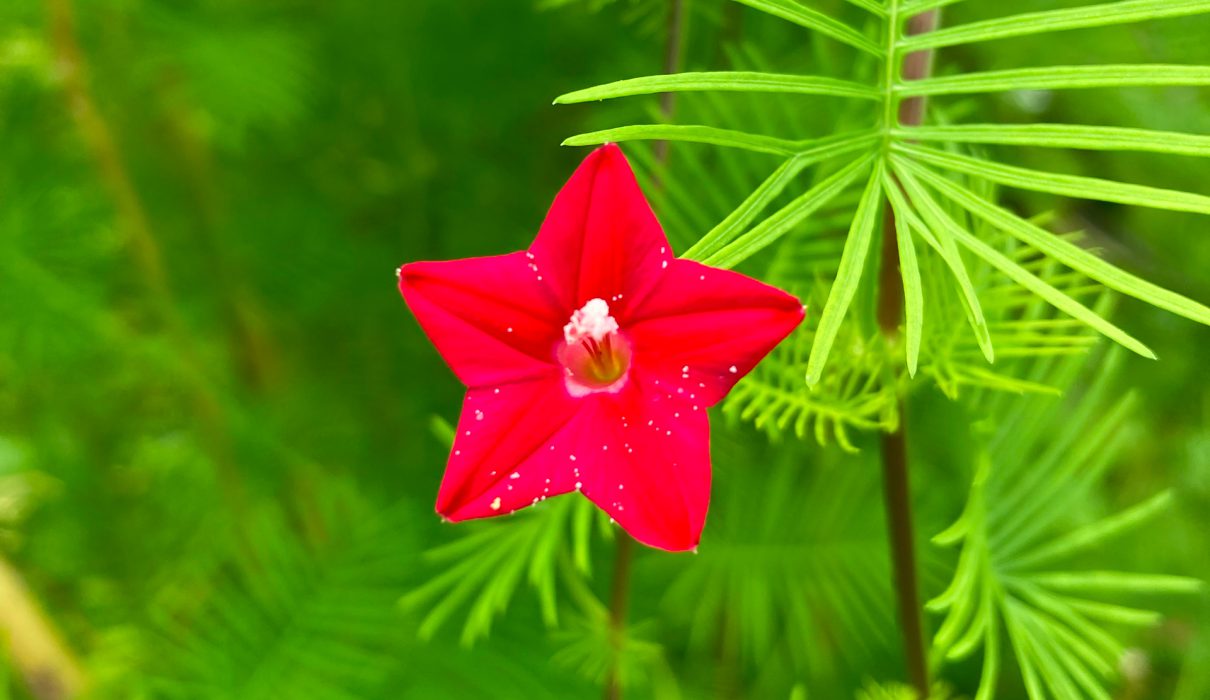Thari Maa (Sathaavareemaa): A Celestial Symphony in Noonu Atoll Lhohi’s Biodiversity
Introduction:
In the tropical embrace of Noonu Atoll Lhohi in the Maldives, a captivating bloom graces our surroundings – the Thari Maa. Aptly named for its star-like allure, combining “Thari” (star) and “Maa” (flower) in Dhivehi, this enchanting flower adorns countless house gardens and thrives near the fringes of the forest, painting our island with its vibrant hues.

Botanical Marvel:
- Scientific Classification:
- Family: Convolvulaceae
- Genus: Ipomoea
- Species: I. quamoclit
Distinctive Features: Thari Maa, a slender twining herb, unfolds its beauty through pinnately dissected leaves, showcasing a delicate dance of vibrant colors. The leaves, measuring 1.5-4.5 cm long, are deeply lobed and narrowly linear. The trumpet-shaped red flowers, 1-2 inches (25-51 mm) long and 1 inch (25 mm) in diameter, add an elegant touch to the island’s rich biodiversity.
Cultural Significance: In Noonu Atoll Lhohi, Thari Maa stands as more than a flower; it symbolizes the starry nights that inspire our island dreams. Found abundantly in house gardens and on the edges of the forest, Thari Maa reflects the harmonious relationship between our island community and the flourishing nature that surrounds us.
Ornamental Beauty: Recognized as an ornamental plant, Thari Maa graces homesteads, turning them into vibrant canvases of color. Its deeply lobed leaves and striking red flowers create a picturesque scene, making it a cherished choice for gardens across the island.

Traditional Uses: Ipomoea quamoclit L is a less studied medicinal plant used as folk medicine globally, noted for its cooling and purgative properties (Asian Journal of Pharmaceutical and Health Sciences). The plant is considered cooling and purgative; used in chest pain, pounded leaves are used as a remedy for bleeding piles and carbuncles. Beyond its aesthetic appeal, Thari Maa contributes to traditional medicine. Pounded leaves find application in addressing bleeding piles, while crushed leaves serve as a plaster for carbuncles, but I have never seen this used in the Maldives for medicinal purposes. This traditional knowledge echoes practices in various regions, where the plant has been used for its medicinal attributes, as noted in some countries.
Sizes and Details:
- Leaves: 1.5-4.5 cm long, deeply lobed, narrowly linear
- Flowers: 1-2 inches (25-51 mm) long, trumpet-shaped, red
- Capsule: 0.8-1 × 0.5-0.6 cm, ovoid; seeds 4, 0.4-0.5 × 0.1-0.15 cm, compressed, conical, black on drying
Taxonomic Insights:
- Dhivehi Name: Sathaavareemaa
- English Names: Ipomoea Quamoclit, Cardinal vine, Morning Glory, Red Jasmine
Distribution and Habitat: Originally native to tropical regions of the Americas, Thari Maa has found a second home in the Maldives, particularly thriving in the warm embrace of Noonu Atoll Lhohi. Its adaptability and robust growth make it a welcomed presence in our island’s diverse flora.
Environmental Considerations: While celebrating its beauty, it’s crucial to note that Thari Maa, with its potential for invasiveness under warm climates, requires careful monitoring. Balancing its ornamental allure with potential ecological impacts calls for environmental caution.
Conclusion: Thari Maa, the star-flower, paints Noonu Atoll Lhohi with its celestial charm. As its vibrant blooms adorn our homes and the edges of the forest, we celebrate not just a flower but a symbol of the profound connection between our island community and the natural wonders that define our beloved Maldives.
References:
- Common-plants-of-Maldives (FAO Publication)
- Asian Journal of Pharmaceutical and Health Sciences


